宾语补足语汇总
宾补动词顺口溜

宾补动词顺口溜
宾语补足语是句中宾语的补充说明,一般与宾语搭配逻辑合理,语法正确,意思通顺。
以下是关于宾补动词的顺口溜,仅供参考:
1. 宾语补足语,切莫胡乱加,动词意思要表达清楚全靠它。
2. have/make/let/see/watch/notice/observe/hear/feel/listen to +宾语+宾补。
3. 动词不定式,有它没划线;to后啥都没,to后很自由。
4. to +及物动词变不定式。
5. 感官动词和使役动词接宾补,省略to来不忘记。
6. 动词原形前面加to,变成不定式。
7. to后接原形,to前加be done。
8. 一感二听三让四看半帮助,主动不能接to。
9. 若被to接通,条件和时间来帮忙。
10. 主从复合句,宾补须加从句中。
宾语补足语
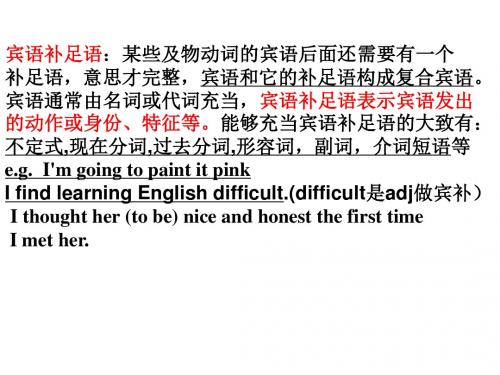
1. The manager discussed the plan that they would like to see the next year.(NMET2000) C A. carry out B. carrying out C. carried out D. to carry out 2. ----There’s a hole in your bag. C ---- I know, I’m going to have it _____. A. mend B. mending C. mended D. to be mended 3. Though he had often made his little sister ____, today he was made ____ by his little sister. A A. cry; to cry B. crying; crying C. cry; cry D. to cry; cry 4. They would not allow him _____ across the enemy line. A. to risk going B. risking to go A C. for risk to go D. risk going
什么是宾语补足语
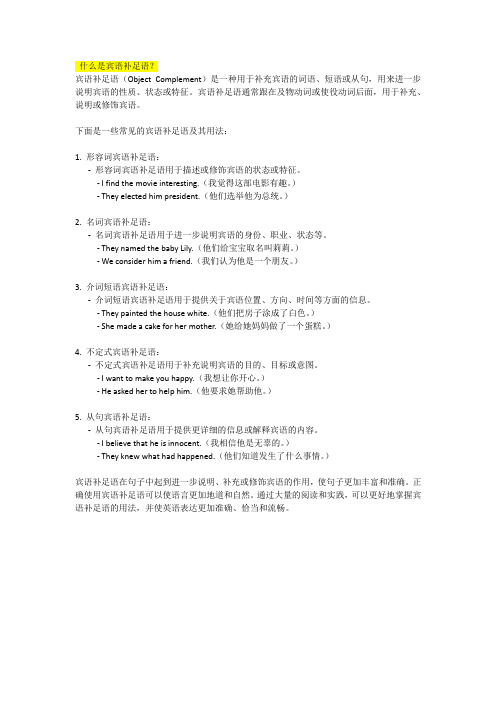
什么是宾语补足语?宾语补足语(Object Complement)是一种用于补充宾语的词语、短语或从句,用来进一步说明宾语的性质、状态或特征。
宾语补足语通常跟在及物动词或使役动词后面,用于补充、说明或修饰宾语。
下面是一些常见的宾语补足语及其用法:1. 形容词宾语补足语:-形容词宾语补足语用于描述或修饰宾语的状态或特征。
- I find the movie interesting.(我觉得这部电影有趣。
)- They elected him president.(他们选举他为总统。
)2. 名词宾语补足语:-名词宾语补足语用于进一步说明宾语的身份、职业、状态等。
- They named the baby Lily.(他们给宝宝取名叫莉莉。
)- We consider him a friend.(我们认为他是一个朋友。
)3. 介词短语宾语补足语:-介词短语宾语补足语用于提供关于宾语位置、方向、时间等方面的信息。
- They painted the house white.(他们把房子涂成了白色。
)- She made a cake for her mother.(她给她妈妈做了一个蛋糕。
)4. 不定式宾语补足语:-不定式宾语补足语用于补充说明宾语的目的、目标或意图。
- I want to make you happy.(我想让你开心。
)- He asked her to help him.(他要求她帮助他。
)5. 从句宾语补足语:-从句宾语补足语用于提供更详细的信息或解释宾语的内容。
- I believe that he is innocent.(我相信他是无辜的。
)- They knew what had happened.(他们知道发生了什么事情。
)宾语补足语在句子中起到进一步说明、补充或修饰宾语的作用,使句子更加丰富和准确。
正确使用宾语补足语可以使语言更加地道和自然。
通过大量的阅读和实践,可以更好地掌握宾语补足语的用法,并使英语表达更加准确、恰当和流畅。
宾语补足语

宾语补足语形容词作宾语补足语,如:We found your kids. You shouldn't have left the kids unattended.(unattended阐述了孩子的状态)孩子我们找到了。
你实在不应该让孩子无人看管。
感官动词feel, find, hear, listen to, see, watch, notice, observe, look at, smell可以接现在分词、过去分词、不带to的不定式充当补足语,如:I see him being murdered.我看着他被人杀害。
(强调动作正在进行凶手正在行凶)I smell something burning in the kitchen.我闻到厨房里有东西正在烧着。
(强调动作正在进行)I saw her murdered outside school gates.我目睹她在校门外被杀害了。
(强调被动她是被杀而不是自杀)Deputies saw a car parked here last night.警员看到一辆车昨晚停在这。
(强调被动车子是被人停放的)I watched you leave.我看着你离开。
(强调动作的整个过程)I once saw him kill three men in a bar.我曾见他在酒吧里杀了三个人。
(强调动作的整个过程)使役动词let, make,have接宾语补足语时,不定式的to必须省略。
Let her go.让她走。
The young couple were both occupied by various matters, so they decided to have it organized bya wedding company. (have + sth + 过去分词意为让别人为自己做某事)夫妻双方都忙,所以他们让婚庆公司来操办他们的婚礼。
动词不定式(to do)作宾语补足语。
宾语补足语七种类型英语举例
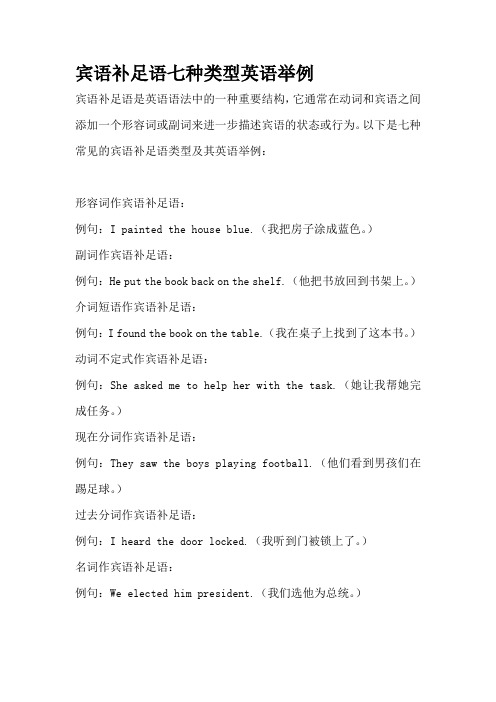
宾语补足语七种类型英语举例
宾语补足语是英语语法中的一种重要结构,它通常在动词和宾语之间添加一个形容词或副词来进一步描述宾语的状态或行为。
以下是七种常见的宾语补足语类型及其英语举例:
形容词作宾语补足语:
例句:I painted the house blue.(我把房子涂成蓝色。
)
副词作宾语补足语:
例句:He put the book back on the shelf.(他把书放回到书架上。
)介词短语作宾语补足语:
例句:I found the book on the table.(我在桌子上找到了这本书。
)动词不定式作宾语补足语:
例句:She asked me to help her with the task.(她让我帮她完成任务。
)
现在分词作宾语补足语:
例句:They saw the boys playing football.(他们看到男孩们在踢足球。
)
过去分词作宾语补足语:
例句:I heard the door locked.(我听到门被锁上了。
)
名词作宾语补足语:
例句:We elected him president.(我们选他为总统。
)
这些是七种常见的宾语补足语类型,每种都有不同的用法和特点。
理解这些结构可以帮助更好地掌握英语语法。
宾语补足语总汇

宾语补足语总汇Company Document number:WTUT-WT88Y-W8BBGB-BWYTT-19998宾语补足语总汇六、具体说明:(一)副词作宾语补足语I found him in yesterday.(二)常接形容词作宾语补足语的动词有:keep, make, find等。
如:We must keep our classroom clean.(三)常接名词作宾语补足语的动词有:call, name, make, think等。
如:We call them mooncakes.(四)常接动词-ing形式作宾语补足语的动词有:see, watch, hear, find, keep 等。
如:In the country, we can hear birds singing.(五)常接介词短语作宾语补足语的动词有:keep, find, leave等。
如:I left my pen on my desk at home.(六)不定式作宾语补足语1. 常接带to的动词不定式作宾语补足语的动词有:ask, tell, want, teach, wish 等;2. 接不带to的动词不定式作宾语补足语的动词有:see, watch, hear, make, let advise, allow, ask, beg, command, tell, invite, force, oblige, get, help, encourage, persuade, permit, remind, request, order, warn, cause等。
如:I often see him play football.She often asks me to help her.We don't allow such things to happen again.Most of the parents agree to forbid their children to smoke.She asked me to answer the phone in her absence.Please remind me to leave her this note.She requested him to go with her.3. 用不定式作宾语补足语的几种说明:①help后面作宾语补足语的动词不定式可以带to也可以不带to。
高考英语专项语法宾语补足语
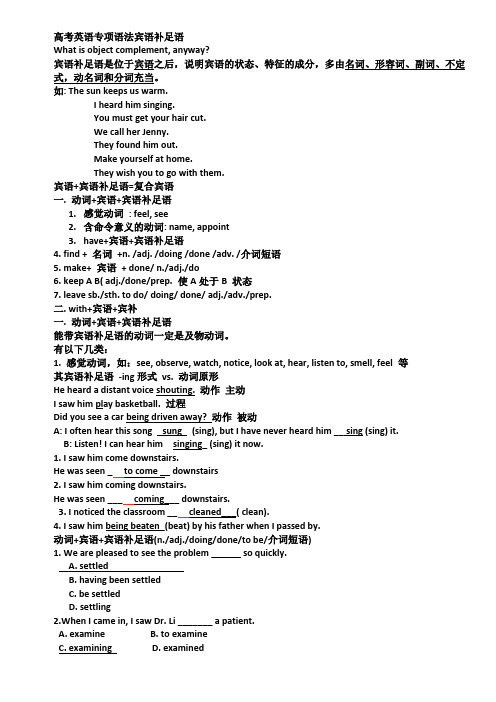
高考英语专项语法宾语补足语What is object complement, anyway?宾语补足语是位于宾语之后,说明宾语的状态、特征的成分,多由名词、形容词、副词、不定式,动名词和分词充当。
如: The sun keeps us warm.I heard him singing.You must get your hair cut.We call her Jenny.They found him out.Make yourself at home.They wish you to go with them.宾语+宾语补足语=复合宾语一. 动词+宾语+宾语补足语1.感觉动词: feel, see2.含命令意义的动词: name, appoint3.have+宾语+宾语补足语4. find + 名词+n. /adj. /doing /done /adv. /介词短语5. make+ 宾语+ done/ n./adj./do6. keep A B( adj./done/prep. 使A处于B 状态7. leave sb./sth. to do/ doing/ done/ adj./adv./prep.二. with+宾语+宾补一. 动词+宾语+宾语补足语能带宾语补足语的动词一定是及物动词。
有以下几类:1. 感觉动词,如:see, observe, watch, notice, look at, hear, listen to, smell, feel 等其宾语补足语-ing形式vs. 动词原形He heard a distant voice shouting. 动作主动I saw him play basketball. 过程Did you see a car being driven away? 动作被动A: I often hear this song sung (sing), but I have never heard him __ sing (sing) it.B: Listen! I can hear him singing_ (sing) it now.1. I saw him come downstairs.He was seen _to come __ downstairs2. I saw him coming downstairs.He was seen ___coming___ downstairs.3. I noticed the classroom __cleaned___( clean).4. I saw him being beaten_(beat) by his father when I passed by.动词+宾语+宾语补足语(n./adj./doing/done/to be/介词短语)1. We are pleased to see the problem ______ so quickly.A. settledB. having been settledC. be settledD. settling2.When I came in, I saw Dr. Li _______ a patient.A. examineB. to examineC. examiningD. examined3. The manager discussed the plan that they would like to see _______the next) year.(NMET2000)A. carry outB. carrying outC. carried out D.to carry out2. 含命名意义的动词,如:call, name, appoint, elect, make, consider等。
宾语补足知识点总结

宾语补足知识点总结一、宾语补足语(宾补)宾语补足语(宾补)是指在及物动词后所需的宾语后面,充当宾语补足的成分,通常由名词、形容词或动词不定式构成。
宾补通常有以下几种类型:1. 名词宾语补足语:通常由名词、代词、数词等构成。
例如:I consider him (to be) my friend.(我认为他是我的朋友。
)2. 形容词宾语补足语:通常由形容词构成。
例如:They found the film (interesting).(他们觉得那部电影很有趣。
)3. 动词不定式宾语补足语:通常由动词不定式构成。
例如:I wanted (to go) there.(我想去那里。
)二、宾语补足成分(宾补成分)宾语补足成分(宾补成分)是指在及物动词后所需的宾语之后,作为宾语补足的成分,通常由名词、代词、形容词或动词不定式构成。
宾补成分的构成形式和用法与宾补基本相同。
三、宾语补足的构成形式宾语补足的构成形式包括:名词补语、形容词补语、副词补语和动词不定式补语。
其中,名词补语、形容词补语和动词不定式补语是比较常见的形式,而副词补语出现的频率较低。
四、宾语补足的用法1. 宾语补足的用法主要包括以下几个方面:(1)表示动作的结果或状态:通常由形容词或动词不定式构成。
例如:He made me (angry).(他惹怒了我。
)(2)表示宾语的补充说明:用于对宾语进行补充或说明。
例如:I find the book (interesting).(我觉得这本书很有趣。
)(3)表示动词的意义:通常由动词不定式构成。
例如:I saw him (go out).(我看见他走出去了。
)2. 在实际应用中,宾语补足通常需符合以下几个原则:(1)宾语补足通常应与及物动词构成逻辑上的完整意思。
(2)宾语补足通常应与及物动词一起构成句子的谓语动词。
(3)宾语补足通常应与及物动词构成合理的语法结构。
五、宾语补足的误用在英语中,有些人容易在使用宾语补足时出现误用。
宾语补足语的归纳总结

宾语补足语的归纳总结宾语补足语是高考英语中常考的,但有许多考生都被难住了,那考生要怎么克服这个难点呢?尚不了解的小伙伴们看过来,下面由小编为你精心准备了“宾语补足语的归纳总结”,持续关注本站将可以持续获取更多的考试资讯!宾语补足语的归纳总结宾语补足语是英语教学中的难点,也是高考的热点,更是书面表达中必须具备的一种句型结构。
中学教学中最常见的使役动词有:make,have,leave。
他们都表示“使得”,后面都可接宾语+宾语补足语的结构,但用法上有所不同。
1. 我们推选他为我们足球队队长。
We made him captain of our football team.2. 我们队赢了的消息使我们大家非常高兴。
The news that our team had won made us very happy.3. 大雨使得我们无法出去。
The heavy rain made it impossible for us to go out.4. 奇怪的声音使我们感到恐惧。
The strange noise made us frightened.5. 在交通嘈杂声中他无法使自己的声音提高到让别人听到。
He couldn’t make himself heard above the noise of the traffic.6. 什么东西使得草生长?What makes the grass grow?注意:过去分词作make的宾语补足语时,变为被动语态不用加to; 但当不定式作其宾补时,变为被动语态一定要加to。
这个男孩被迫每天干十二个小时的活。
The boy was made to work twelve hours a day.1. Paul doesn’t have to be made ____. He always works hard.A. learnB. to learnC. learnedD. learning2. The result of the entrance exams was not made ____ to the public until last Thursday.A. knowingB. knownC. to knowD. to be known答案:1.B2.Bhave sb. do sth.使得某人做某事have sb. doing sth.使得某人一直做某事have sth. done使得某事被做1. The teacher had her ____(recite) the text again.2. He wants to have his eyes ____(examine) tomorrow.3. Be careful, or you’ll have your hands ____(hurt).4. He had the girl ____(stand) in the classroom the whole morning.5. He had the walls ____(paint) this morning.答案:1.recite 2.examined 3.hurt 4.standing 5.painted只能用doing的情况1. 表示正在发生Be quick. They have the car waiting for you at the school gate.2. 否定句中表示(不能)容忍某人做……Iwon’t have him cheating in the exam.3. 表示某一时间内一直延续不断的动作He had us laughing all through the meals.1. I’ve had my radio ____ so soon because my father had me ____ it. A. repair; done B. repaired; do C. repairing; do D. repaired; done2. You can’t have the horse ____ all the way. It’s too hot.A. runB. to runC. runningD. to be running3. Mrs. Brown was much disappointed to see the washing machine she had had ____ went wrong again.A. itB. it repairedC. repairedD. to be repaired4. We will have you ____(know) that the machine has been made ____(work) at full speed.答案:1.B 2.C 3.C 4.know, to work1. 用形容词作宾语补足语出去时,不要关门。
宾语补足语
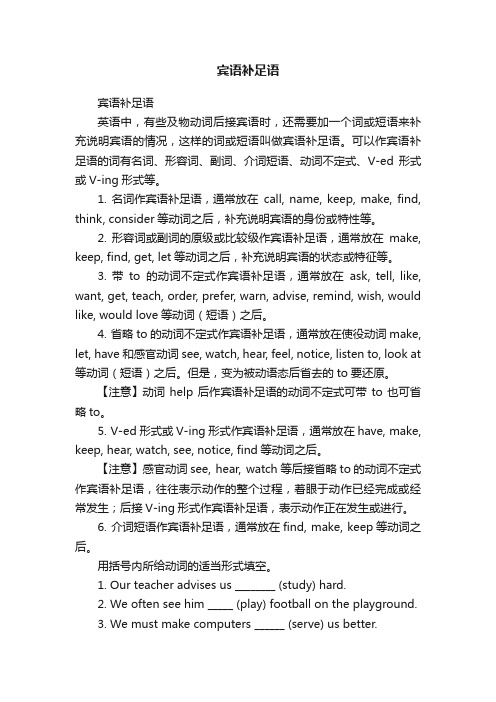
宾语补足语宾语补足语英语中,有些及物动词后接宾语时,还需要加一个词或短语来补充说明宾语的情况,这样的词或短语叫做宾语补足语。
可以作宾语补足语的词有名词、形容词、副词、介词短语、动词不定式、V-ed形式或V-ing形式等。
1. 名词作宾语补足语,通常放在call, name, keep, make, find, think, consider等动词之后,补充说明宾语的身份或特性等。
2. 形容词或副词的原级或比较级作宾语补足语,通常放在make, keep, find, get, let等动词之后,补充说明宾语的状态或特征等。
3. 带to的动词不定式作宾语补足语,通常放在ask, tell, like, want, get, teach, order, prefer, warn, advise, remind, wish, would like, would love等动词(短语)之后。
4. 省略to的动词不定式作宾语补足语,通常放在使役动词make, let, have和感官动词see, watch, hear, feel, notice, listen to, look at 等动词(短语)之后。
但是,变为被动语态后省去的to要还原。
【注意】动词help后作宾语补足语的动词不定式可带to也可省略to。
5. V-ed形式或V-ing形式作宾语补足语,通常放在have, make, keep, hear, watch, see, notice, find等动词之后。
【注意】感官动词see, hear, watch等后接省略to的动词不定式作宾语补足语,往往表示动作的整个过程,着眼于动作已经完成或经常发生;后接V-ing形式作宾语补足语,表示动作正在发生或进行。
6. 介词短语作宾语补足语,通常放在find, make, keep等动词之后。
用括号内所给动词的适当形式填空。
1. Our teacher advises us ________ (study) hard.2. We often see him _____ (play) football on the playground.3. We must make computers ______ (serve) us better.4. My parents told me not _________ (spend) too much time watching TV.5. I saw him _______ (play) basketball when I passed the playground.链接中考1. My roommate often asks me ________ her to play chess.A. teachB. teachingC. to teach2. The woman made his son ______ finally after she told him some jokes .A. laughedB. to laughC. laughD. laughing3. -- I saw Ann ______ a green dress at the school meeting.-- I think she looks better ______ red.A. dressed; inB. put on; wearC. wearing; inD. wear; put on4. The scientist tried his best to make his view ______.A. to understandB. understandC. understoodD. understanding5. The soft music makes me _______ (relax).6. The music makes him ______ (want) to sleep.7. He made me _______(repeat) it.8. The picture makes me _________ (energy).9.Young parents usually don’t know how ________ (make) a baby happy.10.He said again in order to make himself __________ (understand).They also have to know how to make money.他们还必须知道如何赚钱。
宾语补足语汇总.

用所给动词的恰当形式填空: 1. It’s difficult to get a car ___________ (go) to go on a cold morning.
2. His failing the exam got his parents
________ worried (worry). 3. I have had my bike ________ repaired (repair), and I’m going to have my brother ______ repair
1. We consider her performance a big success. 2. Polly heard it hit the step. 3. People believe dogs to be honest.
1. What is Object complement ?? An object complement gives information 宾语补足语是对宾语做出进一步的补充说明 about the object.
D. 只接现在分词的动词有:
Keep , catch , stop , prevent , mind…
Eg. She caught her son smoking in the room.
Exercise:
1. The workers here are made to work ____________(work) ten hours a day. 2. The missing boy was last playing seen ___________(play) by the riverside.
C. 接不带to的不定式做宾补的动词:
宾语补足语 英语

宾语补足语英语
在英语中,宾语补足语(Object Complement)是一种语法成分,用于补充说明宾语的状态、特征或身份。
宾语补足语通常出现在及物动词或短语动词之后,与宾语一起构成完整的句子。
以下是一些宾语补足语的常见类型和示例:
1.名词/代词作为宾语补足语:
例如:We elected him president.(我们选他当总统。
)在这个句子中,“him”是宾语,“president”是名词作为宾语补足语,说明“him”的身份。
2.形容词作为宾语补足语:
例如:She found the book interesting.(她觉得这本书很有趣。
)在这个句子中,“the book”是宾语,“interesting”是形容词作为宾语补足语,描述“the book”的特征。
3.动词不定式作为宾语补足语:
例如:My mother asked me to clean the room.(我妈妈让我打扫房间。
)在这个句子中,“me”是宾语,“to clean the room”是动词不定式作为宾语补足语,表示“me”要做的动作。
4.过去分词作为宾语补足语:
例如:I saw the boy playing in the park.(我看见那个男孩在公园里玩。
)在这个句子中,“the boy”是宾语,“playing”是过去分词作为宾语补足语,描述“the boy”的状态。
需要注意的是,宾语补足语与宾语从句不同。
宾语从句是一个完整的句子作为宾语,而宾语补足语则是单词、短语或非完整句子作为宾语的补充说明。
宾语补足语知识点总结

宾语补足语知识点总结一、不定式作宾语补足语1. 不定式作宾语补足语的用法不定式作宾语补足语时,它通常跟在及物动词后面,用来说明动作的目的或目标。
例如:- I want to learn English.- He likes to play basketball.- She needs to finish her homework.2. 不定式作宾语补足语的形式不定式有两种形式:带to的一般式和省略to的不定式。
例如:- I want to go to the library. (带to的一般式)- He needs to study for the exam. (带to的一般式)- She likes swimming. (省略to的不定式)3. 表示感官、情感、思维等动词后的不定式宾语补足语- feel, hear, listen to, notice, see, watch, observe, smell, think, believe, consider, expect, find, know, understand, want, like, love, hate, etc.例如:- I heard her sing the song.- She likes to read novels in her free time.- He found it difficult to solve the problem.4. 表示目的、意图或计划后的不定式宾语补足语- aim, attempt, decide, determine, hope, intend, plan, promise, refuse, try, wish, etc.例如:- He decided to buy a new car.- She promised to finish the project on time.- They plan to go on a trip next month.5. 表示请求、要求或命令后的不定式宾语补足语- advise, allow, ask, invite, command, encourage, force, forbid, instruct, need, order, permit, remind, require, tell, urge, want, etc.例如:- I asked her to help me with my homework.- She reminded him to call his mother.- The teacher required the students to submit their assignments on time.二、动名词作宾语补足语1. 动名词作宾语补足语的用法动名词作宾语补足语时,它通常跟在及物动词后面,用来说明动作的目的或目标。
宾语补足语七种类型及要点
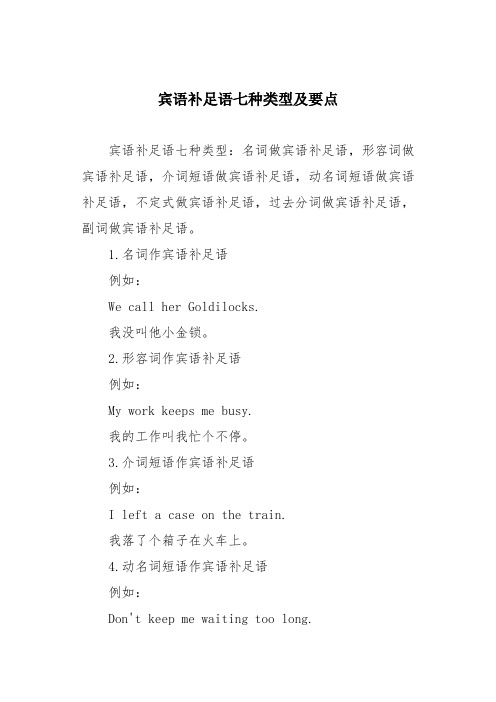
宾语补足语七种类型及要点宾语补足语七种类型:名词做宾语补足语,形容词做宾语补足语,介词短语做宾语补足语,动名词短语做宾语补足语,不定式做宾语补足语,过去分词做宾语补足语,副词做宾语补足语。
1.名词作宾语补足语例如:We call her Goldilocks.我没叫他小金锁。
2.形容词作宾语补足语例如:My work keeps me busy.我的工作叫我忙个不停。
3.介词短语作宾语补足语例如:I left a case on the train.我落了个箱子在火车上。
4.动名词短语作宾语补足语例如:Don't keep me waiting too long.不要让我怎么样、5.不定式作宾语补足语例如:I asked him to help me.我要他帮我。
6.过去分词作宾语补足语例如:Could you make yourself understood?你能让自己被理解吗?7.副词作宾语补足语例如:Don't let your parents down.不要让你的父母失望。
宾语补足语适用类型:1.在表示心理状态的动词后作宾语补足语。
这类动词有:consider,think,believe,discover,find,imagine,judge,suppose,prove等。
这类动词后的不定式通常是“to be+形容词或名词”结构,think,consider,find后的to be常可省略。
例如:We consider him (to be) a good teacher.我们认为他是一个好老师。
2.在表示情感状态的动词后作宾语补足语。
这类动词有:love,like,prefer,hate,want,wish,expect等。
例如:I'd prefer you to leave him alone.我希望你不要打扰他。
3.注意:hope,demand,suggest等动词后面不能接不定式作宾语补足语。
宾补知识点总结

宾补知识点总结一、概念宾语补足语是对及物动词的宾语进行补充说明的成分,它包括了形容词、名词、介词短语、副词、不定式、动名词等。
在句子中,宾语补足语通常紧跟在及物动词的宾语之后,用来对宾语进行进一步的说明和补充。
二、分类1. 形容词宾语补足语形容词宾语补足语是指由及物动词的宾语和形容词构成的宾补结构。
例如:- 他认为这个问题很困难。
- 她觉得那本小说很有趣。
2. 名词宾语补足语名词宾语补足语是由及物动词的宾语和名词构成的宾补结构。
例如:- 他把这个消息告诉了大家。
- 她认为学好英语是非常重要的。
3. 介词宾语补足语介词宾语补足语是由及物动词的宾语和介词短语构成的宾补结构。
例如:- 她把钱花在了买衣服上。
- 他将全部时间投入到了学习上。
4. 副词宾语补足语副词宾语补足语是由及物动词的宾语和副词构成的宾补结构。
例如:- 我认为她表现得非常出色。
- 他把时间利用得很好。
5. 不定式宾语补足语不定式宾语补足语是由及物动词的宾语和不定式构成的宾补结构。
例如:- 他认为这个问题需要进一步研究。
- 她把书读完了。
6. 动名词宾语补足语动名词宾语补足语是由及物动词的宾语和动名词构成的宾补结构。
例如:- 他坚持每天锻炼身体。
- 她忘记了提前告诉他。
三、用法1. 宾语补足语通常紧跟在及物动词的宾语之后,用来对宾语进行进一步的说明和补充。
例如:- 他认为这份工作非常有挑战性。
- 她把这个问题考虑得非常周密。
2. 省略的宾语在口语中常常可以进行省略,但是在正式的书面语中不宜省略。
例如:- 他认为海滩上的沙子很柔软。
(宾语“沙子”省略了)- 她觉得这本书非常有趣。
(宾语“书”省略了)3. 宾补与宾语的关系宾补与宾语之间通常是一种补充关系,宾补对宾语进行了进一步的说明和补充,从而使句子的信息更加完整。
例如:- 他认为这个问题很重要。
(宾语“问题”→宾补“很重要”)- 她把这个消息告诉了大家。
(宾语“消息”→宾补“告诉了大家”)四、常见误区1. 宾语与宾补的搭配错误有些学生在使用宾语补足语时,可能会将宾语与宾补的搭配弄错,导致句子不通顺。
接宾语补足语的动词汇总

常跟【2 】复合宾语的动词有:call(叫),named(叫做),make(做),think(思虑),find(找),leave(分开),keep(保持),nominate(录用),choose,elect(选举),define(界说),regard(以为), see(看),recognize(认出),treat,take,consider (斟酌),look up,refer to(提到),accept(接收),acknowledge(承认),describe,depict (描写),represent(表现出),declare(传播鼓吹),denounce(责备),employ(雇佣),use(应用),show(展现),organize,express(表达)等.接不定式作宾补的36个常用动词advise sb. to do sth. 建议或人做某事allow sb. to do sth. 许可或人做某事ask sb. to do sth.请(叫)或人做某事bear sb. to do sth.忍耐或人做某事beg sb. to do sth. 请求或人做某事cause sb. to do sth. 导致或人做某事command sb. to do sth. 敕令或人做某事drive sb. to do sth .使令或人做某事elect sb. to do sth. 选举或人做某事encourage sb. to do sth. 勉励或人做某事expect sb. to do sth. 期望或人做某事forbid sb. to do sth. 制止或人做某事force sb. to do sth. 强制或人做某事get sb. to do sth. 使(要)或人做某事hate sb. to do sth. 憎恶或人做某事help sb. to do sth. 关心或人做某事intend sb. to do sth. 打算要或人做某事invite sb. to do sth. 邀请或人做某事leave sb. to do sth. 留下或人做某事like sb. to do sth. 爱好或人做某事mean sb. to do sth. 打算要或人做某事need sb. to do sth. 须要或人做某事oblige sb. to do sth. 迫使或人做某事order sb. to do sth. 敕令或人做某事permit sb. to do sth. 许可或人做某事persuade sb. to do sth. 说服或人做某事prefer sb. to do sth. 情愿或人做某事request sb. to do sth. 请求或人做某事remind sb. to do sth. 提示或人做某事teach sb. to do sth .教或人做某事tell sb. to do sth. 告知或人做某事train sb. to do sth. 练习或人做某事trouble sb. to do sth. 麻烦或人做某事want sb. to do sth. 想要或人做某事warn sb. to do sth. 警告或人做某事wish sb. to do sth. 愿望或人做某事汉语的“谅解或人做某事”,英语可说成excuse [forgive] sb. for doing sth.. 汉语的“愿望或人做某事”,英语可说成wish sb. to do sth..汉语的“建议或人做某事”,英语可说成advise sb. to do sth..汉语的“安排或人做某事”,英语可说成arrange for sb. to do sth..汉语的“请求或人做某事”,英语可说成demand of sb. to do sth..汉语的“感激或人做某事”,英语可说成thank sb. for doing sth..汉语的“祝愿或人做某事”,英语可说成congratulate sb. on doing sth..汉语的“阻拦或人做某事”,英语可说成prevent sb. from doing sth..接如今分词作宾补的20个常用动词bring sb. doing sth.引起或人做某事 catch sb. doing sth. 碰上(撞上)或人做某事discover sb. doing sth. 发明或人做某事 feel sb. doing sth. 感到或人做某事find sb. doing sth. 碰上(撞上)或人做某事 get sb. doing sth. 使或人做某事have sb. doing sth. 使或人做某事 hear sb. doing sth. 听见或人做某事keep sb. doing sth. 使或人不停地做某事 listen to sb. doing sth. 听或人做某事look at sb. doing sth. 看着或人做某事 notice sb. doing sth. 留意到或人做某事observe sb. doing sth. 不雅察或人做某事 prevent sb. doing sth. 阻拦或人做某事see sb. doing sth. 看见或人做某事 send sb. doing sth.使或人(忽然)做某事set sb. doing sth. 使(引起)或人做某事 start sb. doing sth. 使或人开端做某事stop sb. doing sth. 阻拦或人做某事 watch sb. doing sth. 不雅察或人做某事接动词本相作宾补的11个常用动词feel sb. do sth. 感到或人做某事 have sb. do sth. 使或人做某事hear sb. do sth. 听见或人做某事 let sb. do sth.让或人做某事listen to sb. do sth. 听着或人做某事 look at sb. do sth. 看着或人做某事make sb. do sth. 使或人做某事 notice sb. do sth. 留意或人做某事observe sb. do sth. 不雅察或人做某事 see sb. do sth. 看见或人做某事watch sb. do sth. 不雅察或人做某事在某些短语后也可跟带to的不定式作宾补.这类动词短语常见的有:wait for,call on,depend on,care for,long for等.例如:The crocodile waited for the monkey to come down again.鳄鱼等着山公再下来.The chairman called on Mr Brown to speak.主席请布朗师长教师讲话.I shouldn't care for that man to be my doctor.我不要那人给我看病.不带to的不定式作宾补动词不定式在使役动词(make,let, have)或感官动词(feel,listen to,hear, look at,see,watch,notice)之后作宾补时不定式需省去to.为了便于记忆,我们可以如许记“一感”(feel).“二听”(listen to, hear).“三让”(let,make,have).“四看”(look at,see,watch,notice).。
宾语补足语的种类和用法

宾语补足语的种类和用法宾语补足语是指在句子中用来补充说明动词的宾语的成分,它可以是名词、形容词、副词、介词短语等。
宾语补足语的种类和用法涉及到语法的一些细节和规则,下面将对此进行详细讨论。
一、名词性宾语补足语名词性宾语补足语是句子中的宾语补充说明名词,可以是名词、代词、不定式、动名词等。
1.名词宾语补足语名词宾语补足语一般由名词组成,用来进一步说明宾语。
例如:He considered the book a gift.(他把这本书视为一份礼物。
)They elected him chairman.(他们选他当了主席。
)2.代词宾语补足语代词宾语补足语可以是代词,用来补充说明宾语。
例如:I find it hard to understand.(我发现很难理解。
)We made her our leader.(我们让她成为我们的领导。
)3.不定式宾语补足语不定式宾语补足语是用不定式形式的动词来作宾语补充说明宾语。
例如:I want to be a doctor.(我想成为一名医生。
)She asked me to help.(她让我帮忙。
)4.动名词宾语补足语动名词宾语补足语用动名词形式的动词来作宾语补充说明宾语。
例如:I enjoy swimming.(我喜欢游泳。
)They don't mind waiting.(他们不介意等待。
)二、形容词性宾语补足语形容词性宾语补足语是用形容词来修饰宾语,进一步说明宾语的特征。
1.表语形容词作宾语补足语表语形容词作宾语补足语用来补充说明宾语的状态或特征。
例如:She found the movie boring.(她觉得这部电影很无聊。
)We consider him intelligent.(我们认为他聪明。
)2.定语形容词作宾语补足语定语形容词作宾语补足语用来修饰宾语的性质或特点。
例如:They found the city beautiful.(他们觉得这个城市很美。
宾语补足语
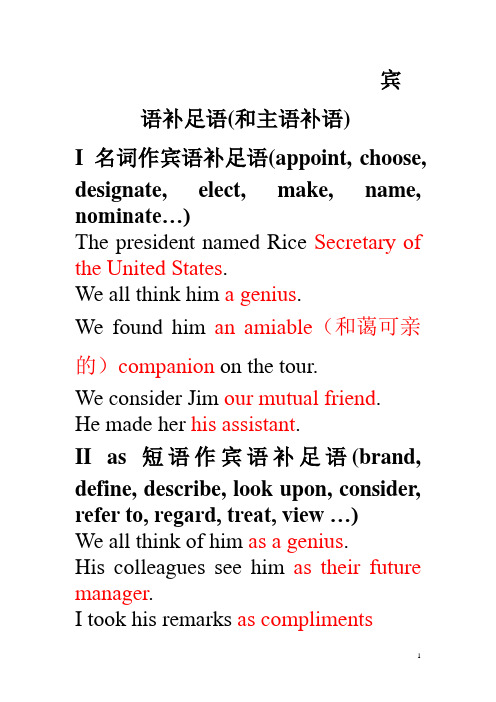
宾语补足语(和主语补语)I 名词作宾语补足语(appoint, choose, designate, elect, make, name, nominate…)The president named Rice Secretary of the United States.We all think him a genius.We found him an amiable(和蔼可亲的)companion on the tour.We consider Jim our mutual friend.He made her his assistant.II as 短语作宾语补足语(brand, define, describe, look upon, consider, refer to, regard, treat, view …)We all think of him as a genius.His colleagues see him as their future manager.I took his remarks as complimentsThe newspapers labelled him as a troublemaker.III形容词作宾语补足语( make, drive, get, send, render, cut, keep, leave; prove, consider, believe, find reckon…)Billy’s silence made her uneasy.They are driving me crazy.She painted her eyelids deep blue. Please leave the window open.We found him difficult to understand. IV非谓语动词作宾语补足语1不定式短语①带to的不定式(ask, tell, allow want advise expect persuade remind, require…)We don’t allow people to smoke in here.②省略to的不定式(make, have, let,help; feel, hear, notice, see, observe, watch…)She made her son clean up his own room.They had someone paint their house.I heard the doorbell ring three times.2现在分词(feel, hear, notice, see, observe, watch; keep, catch, send, set, leave, find, imagine, picture…)I heard someone knocking at the door.I am sorry to have kept you waiting. The teacher caught a student cheating in the exam.We shouldn’t leave water running. Imagine yourself winning and you will make it.3过去分词(have, want, see, make, leave, get, find…)School science courses, I remember, concentrated on the unimportant parts of science, leaving the major insightsalmost untouched.The secretary will keep the manager well informed of what is going on.I’ll have my paper finished this evening.V 介词短语作宾语补足语Please make yourself at home.I found my keys in my drawer.VI 副词Do you think them in?He might have gone a step further and called for respect for both our economists and our trashmen; otherwise, they will both leave garbage behind.动词不定式,分词(过去分词或现在分词)作宾语补足语:1.l et, make, hear, watch, notice, have2.Y ou have to have your luggage ______ (weigh) here.3.I t’s difficult to make yourself ______ (understand) if you don’t know their language.4.O nce a year the retired people have their health _____ (check).5.I’m sorry to have kept you ____ (wait).6.W e found him _______ (lie) in the street.7.I found her quite ______ (disappoint).8.T hey went home, leaving their work _____ (unfinish).9.D on’t leave the water _______ (run).10.We can see the product ______ (advertise) everywhere.11.He managed to get everything ______ (do) in such a short time. 12.My mother cannot bear people ______ (talk) when a film is on TV.13.She couldn’t bear to leave her aging parents to live by themselves.主语补足语:1.S he looked at her exercise-books ______ (tire and sleep).2.T hey went home _______ (exhaust)3.S he read his letter ________ (heart, break).4.T he door was found ______ (unlock).5.T he residents were urged ________ (leave) their houses immediately.6.E verything in the room was left _______ (untouch).。
宾语补足语总汇

宾语补足语总汇六、具体说明:(一)副词作宾语补足语I found him in yesterday.(二)常接形容词作宾语补足语的动词有:keep, make, find等。
如:We must keep our classroom clean.(三)常接名词作宾语补足语的动词有:call, name, make, think等。
如:We call them mooncakes.(四)常接动词-ing形式作宾语补足语的动词有:see, watch, hear, find, keep等。
如:In the country, we can hear birds singing.(五)常接介词短语作宾语补足语的动词有:keep, find, leave等。
如:I left my pen on my desk at home.(六)不定式作宾语补足语1. 常接带to的动词不定式作宾语补足语的动词有:ask, tell, want, teach, wish等;2. 接不带to的动词不定式作宾语补足语的动词有:see, watch, hear, make, let advise, allow, ask, beg, command, tell, invite, force, oblige, get, help, encourage, persuade, permit, remind, request, order, warn, cause等。
如:I often see him play football.She often asks me to help her.We don't allow such things to happen again.Most of the parents agree to forbid their children to smoke.She asked me to answer the phone in her absence.Please remind me to leave her this note.She requested him to go with her.3. 用不定式作宾语补足语的几种说明:①help后面作宾语补足语的动词不定式可以带to也可以不带to。
- 1、下载文档前请自行甄别文档内容的完整性,平台不提供额外的编辑、内容补充、找答案等附加服务。
- 2、"仅部分预览"的文档,不可在线预览部分如存在完整性等问题,可反馈申请退款(可完整预览的文档不适用该条件!)。
- 3、如文档侵犯您的权益,请联系客服反馈,我们会尽快为您处理(人工客服工作时间:9:00-18:30)。
宾语补足语汇总一、定义:宾语补足语通常紧跟在宾语之后,对宾语进行补充说明。
二、句子结构是:主+谓+宾+宾补三、两种结构:1.主表型:1) make our country beautiful (adjective)2) call him Lao Li (noun)3) find sb. out (adv.)4) find sb. at home (Prep. phrase)2. 主谓型:1) ask sb. to do sth.(有to 不定式)2) have sb. do sth. (无to 不定式)3) see sb. doing sth. (现在分词)4) have sth. done. (过去分词)四、什么动词后可有宾语补足语:1. 在表示心理状态的动词后作宾语补足语。
这类动词有:consider, think, believe, discover, find, imagine, judge, suppose, prove等。
这类动词后的不定式通常是"to be+形容词或名词"结构,think, consider, find后的to be常可省略。
We consider him (to be) a good teacher.我们认为他是一个好老师。
He proved that theory (to be) very important.他证明那个理论是很重要的。
I thought her (to be) nice and honest the first time I met her.我第一次见到她的时候就认为她人很好,很诚实。
2. 在表示情感状态的动词后作宾语补足语。
这类动词有:love, like, prefer, hate, want, wish, expect等。
I'd prefer you to leave him alone.我希望你不要打扰他。
I don't want there to be any trouble.我不想有任何麻烦。
3. 注意:hope, demand, suggest等动词后面不能接不定式作宾语补足语。
I hope you can give me a hand.我希望你能帮我一把。
I wish you to give me a hand.我希望你能帮我一把。
He required us to be present at the meeting.他要求我们出席会议。
Mr Li suggested that she should not go there alone.李先生建议她不要独自去那里。
五、可作宾语补足语的形式有:不定式,现在分词,过去分词,名词,形容,副词,介词短语都能作补语。
六、具体说明:(一)副词作宾语补足语I found him in yesterday.(二)常接形容词作宾语补足语的动词有:keep, make, find等。
如:We must keep our classroom clean.(三)常接名词作宾语补足语的动词有:call, name, make, think等。
如:We call them mooncakes.(四)常接动词-ing形式作宾语补足语的动词有:see, watch, hear, find, keep 等。
如:In the country, we can hear birds singing.(五)常接介词短语作宾语补足语的动词有:keep, find, leave等。
如:I left my pen on my desk at home.(六)不定式作宾语补足语1. 常接带to的动词不定式作宾语补足语的动词有:ask, tell, want, teach, wish等;2. 接不带to的动词不定式作宾语补足语的动词有:see, watch, hear, make, let advise, allow, ask, beg, command, tell, invite, force, oblige, get, help, encourage, persuade, permit, remind, request, order, warn, cause 等。
如:I often see him play football.She often asks me to help her.We don't allow such things to happen again.Most of the parents agree to forbid their children to smoke.She asked me to answer the phone in her absence.Please remind me to leave her this note.She requested him to go with her.3. 用不定式作宾语补足语的几种说明:①help后面作宾语补足语的动词不定式可以带to也可以不带to。
如:I often help my mother(to) do some housework.②在使役动词后作宾语补足语,不定式不带to。
有些动词跟不定式作宾语补足语时省去了to,这些动词有:一感二听三让四观看。
一感:feel二听:hear, listen to三让:let, have, make四观看:observe, see, watch, look at这类动词有:make, let, have等。
转为被动语态时,其后通常都用带to的不定式 (have没有被动语态)。
What would you have me do?你要我做什么?She made him give up smoking.她让他戒了烟。
Let him do whatever he wishes to do.他想干什么就让他干吧。
Though he had often made his little sister cry, today he was made to cry by his littlesister.虽然经常是他弄哭小妹妹,但今天他却被小妹妹弄哭了3. 掌握“使役动词 have + 宾语+过去分词”的几种含义在“ have +宾语+过去分词”结构中,过去分词作宾语补足语, have 也可用 get 。
这一结构具有以下几种含义:①意为“主语请别人做某事”。
例如:He wants to have his eyes examined tomorrow.他明天想去检查眼睛。
(“检查”的动作由医生来进行)②意为“主语遭遇、遭受某一不愉快、不测的事情”。
例如:Be careful, or you'll have your hands hurt.当心,否则会弄伤手的。
③意为“使完成某事”,事情既可以是别人做完,也可以由主语参与完成。
例如:He had the walls painted this morning.他今早把墙漆了。
(主语自己可能参与)④动词不定式也可作一些短语动词的宾语补足语。
I'm waiting for James to arrive.我正等着詹姆斯的到来。
He's arranged for a car to pick them up at the station.他已安排了一辆汽车去车站接他们。
The UN has called on both sides to observe the cease fire.联合国号召交战双方遵守停火协定。
(七)分词作宾语补足语用现在分词作宾补,说明宾语是动作的发出者,形成逻辑上的主谓关系;用过去分词作宾补,表示宾语是动作的承受者,构成逻辑上的动宾关系。
1. 跟分词作宾补的动词有:catch, have get, keep, hear, find, feel, leave, make, want, start, notice, observe, watch, set等。
例如:There was so much noise that the speaker couldn’t make himself heard.由于十分吵闹,讲话人没法让人听到他的声音。
When he awoke, he found himself being looked after by an old woman. 他醒来的时候发现一位老大娘正在照顾他。
2. 几种用过去分词作宾语补足语的情况说明:①表示“意欲;命令”的动词如 like, want, wish, order 等,可用过去分词作宾语补足语。
例如:The father wants his daughter taught the piano.这位父亲想让女儿学钢琴。
②感官动词 see, hear, notice, observe, watch, feel, find 等后,可用过去分词作宾语补足语。
例如:I saw an old man knocked down by a car just now.刚才我看到一位老人被车撞倒了。
③使役动词 have, get, make, leave, keep 等后,可用过去分词作宾语补足语。
例如:Have you got your films developed? 你拿胶卷去冲洗了没有?④“ with +宾语+过去分词”结构中,过去分词用作介词 with 的宾语补足语。
这一结构通常在句中作时间、方式、条件、原因等状语。
例如:The murderer was brought in, with his hands tied behind his back.凶手被带进来了,他的双手被绑在背后。
(表方式)With water heated, we can see the steam.水一被加热,我们就会看到水蒸气。
(表条件)With the matter settled, we all went home.事情得到解决,我们都回家了。
(表原因)注意:①在这一结构中,当宾语为某一身体部位,且作宾补的动词是及物动词时,身体部位通常是过去分词的逻辑宾语,因而过去分词。
例如:She stood in front of him, with her eyes fixed on his face.她站在他面前,眼睛注视着他。
( fix one's eyes on 为固定短语,因此,不可将句中 fixed 换为 fixing )He stood for an instant with his hand still raised.他仍然举着手站了一会儿。
